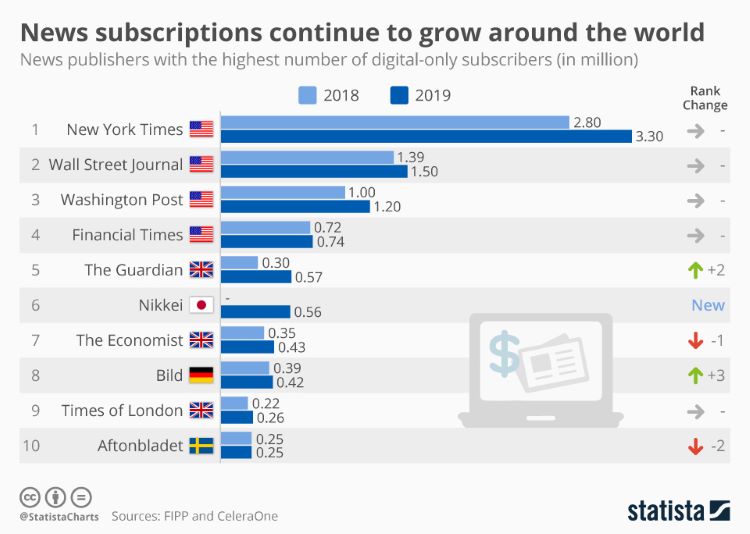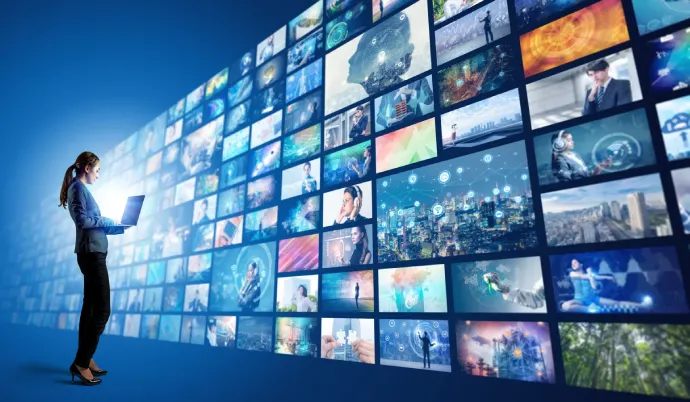The Rise of Subscription
The Rise of Subscription services has transformed the way we consume products and services. From streaming platforms to meal kits, subscription models offer convenience and personalized experiences that cater to individual needs. This shift has not only changed consumer behavior but has also disrupted traditional business models, leading to a more flexible and customer-centric marketplace.
As businesses adapt to this growing trend, The Rise of Subscription is becoming a defining feature of modern commerce. Companies are finding new ways to deliver value and build long-term relationships with their customers.
From Print to Digital: The Transition in News Media
The transition from print to digital news media marks a significant evolution in how information is disseminated and consumed. This shift, driven by technological advancements and changing consumer habits, has had profound implications for the news industry, reshaping the landscape of journalism and altering the relationship between news organizations and their audiences.
The Rise of Subscription
Historically, print media served as the primary source of news for the public. Newspapers, magazines, and journals dominated the market, with daily or weekly editions delivering a curated selection of news stories, editorials, and features.
The business model for print media relied heavily on revenue from subscriptions and advertising, which supported the extensive costs associated with printing and distribution. This model also allowed for rigorous editorial standards, with fact-checking and investigative journalism being cornerstones of reputable news organizations.
The Role of Social Media in Modern News Consumption
Social media has fundamentally altered the landscape of news consumption, transforming how news is disseminated, accessed, and engaged with by the public. For instance, platforms like Facebook, Twitter, and Instagram have become primary sources of news for millions of people worldwide.
Additionally, these platforms blend social interaction with information sharing in unprecedented ways. As a result, this shift has brought about significant changes in the way news is produced, consumed, and perceived.
The Rise of Subscription
Social media platforms have also democratized news production, giving rise to citizen journalism. Individuals can now report on events from their unique perspectives, providing real-time updates and personal accounts that traditional media outlets might not cover.
This has expanded the diversity of voices in the media landscape, offering alternative viewpoints and grassroots reporting. However, it also raises questions about the credibility and reliability of information, as not all content creators adhere to journalistic standards.
Moreover, social media algorithms play a critical role in shaping news consumption. These algorithms prioritize content based on user engagement, often favoring sensational or emotionally charged stories that are more likely to be shared.
This can lead to the amplification of specific narratives, sometimes at the expense of more balanced or in-depth reporting. The echo chamber effect, where users are exposed primarily to information that aligns with their existing beliefs, further complicates the issue. This phenomenon can reinforce biases and contribute to the polarization of public opinion.
The Rise of Subscription
The Rise of Mobile News: News on the Go
The proliferation of smartphones has revolutionized the way people consume news, giving rise to the phenomenon of mobile news. This shift towards mobile-first news consumption has had profound implications for both news producers and consumers, shaping the future of journalism and information dissemination.
Mobile devices offer unparalleled convenience and accessibility, allowing users to stay informed anytime, anywhere. This has led to a significant increase in the consumption of news on the go.
People now read news articles, watch videos, and follow live updates during their commute, while waiting in lines, or during breaks at work. The portability of smartphones ensures that news is no longer confined to specific times or places, making it a constant presence in users’ daily lives.
The rise of mobile news has also influenced the format and presentation of news content. To cater to the mobile audience, news organizations have adapted their content to be more concise and visually engaging. Short articles, bullet-point summaries, and videos optimized for small screens have become common.

Personalization and Algorithms: Tailoring News to the Individual
The integration of personalization and algorithms in news consumption has significantly transformed how individuals receive and interact with information. This shift towards tailored news experiences leverages advanced data analytics and machine learning to deliver content that aligns with users’ interests, preferences, and behaviors.
Personalization has several advantages, including increased relevance and convenience. For instance, users are more likely to encounter news stories that interest them, making their news consumption experience more engaging and efficient.
Moreover, this tailored approach also helps users discover new content and sources that they might not have found otherwise, potentially broadening their perspectives within their areas of interest.
Additionally, the focus on user engagement can sometimes lead algorithms to prioritize sensationalist or emotionally charged content, which in turn distorts the information landscape. Consequently, the ethical implications of algorithm-driven news personalization become a critical consideration.es their existing beliefs and viewpoints.
This can limit exposure to diverse perspectives and contribute to increased polarization in society. Additionally, the focus on user engagement can sometimes lead algorithms to prioritize sensationalist or emotionally charged content. As a result, this tendency distorts the information landscape. Consequently, the ethical implications of algorithm-driven news personalization become a critical consideration.
The Rise of Subscription
The Impact of Digital Subscription Models on News Consumption
Digital subscription models have become a cornerstone for sustaining journalism in the digital age, fundamentally changing how news is accessed and consumed. As traditional advertising revenues decline, many news organizations have turned to subscription-based models to generate steady income and maintain financial viability.
This shift can lead to more comprehensive investigative reporting, feature stories, and expert analysis, which are often underfunded in ad-supported models. By focusing on content that adds value, subscription models aim to build a loyal and engaged readership willing to pay for reliable news.
Subscription models also affect the accessibility of news. While they provide a vital revenue stream for news organizations, they can create barriers for individuals who cannot afford to pay for multiple subscriptions. This “paywall” effect can limit access to information, potentially exacerbating inequalities in news consumption.
| Impact Area | Description | Examples |
|---|---|---|
| Quality of Journalism | Encourages high-quality, in-depth reporting to justify subscription costs. | Investigative reports, feature stories |
| Accessibility | Can create barriers for those who cannot afford subscriptions, potentially limiting access to information. | Paywalls, tiered subscription options |
| Reader Engagement | Fosters a direct relationship with readers, leading to deeper engagement with content and participation in discussions. | Subscriber forums, reader feedback loops |
| Revenue Stability | Provides a steady income stream independent of volatile advertising markets, ensuring financial viability for news organizations. | Monthly/annual subscription fees |
| Innovation in Offerings | Prompts news organizations to diversify their offerings with additional features to attract and retain subscribers. | Exclusive newsletters, podcasts, webinars |
| Ethical Journalism | Reduces reliance on clickbait and sensationalism, focusing instead on content that adds real value and meets journalistic standards. | Thoroughly researched articles |
| Public Service Balance | Efforts to balance revenue generation with public service by offering free trials, discounted rates for students and low-income readers, and some free content. | Discounted subscription rates |
Challenges and Criticisms of Subscription-Based News Services
Subscription-based news services, while providing a sustainable revenue model for journalism, face several challenges and criticisms that impact their effectiveness and reach. One of the primary challenges is the issue of accessibility.
Subscription models can create barriers to information, particularly for individuals who cannot afford multiple subscriptions. This paywall effect may limit access to important news and information, potentially contributing to a divide between those who can afford to pay for news and those who cannot.
Another significant criticism concerns the potential for market saturation. As more news organizations adopt subscription models, the competition for subscribers intensifies. This can lead to fragmentation in the news market, where readers may need to subscribe to multiple services to access a comprehensive range of news.
FAQs
Q:What are the different types of subscription models for news services?
Subscription models vary from metered paywalls, which allow limited free access before requiring a subscription, to fully gated content where all articles are behind a paywall. Other models include freemium services, where some content is free but premium content requires payment.
Q:How do subscription-based news services benefit news organizations?
Subscription-based models provide a stable revenue stream independent of advertising. They also incentivize the production of high-quality, in-depth journalism, and help news organizations build a direct relationship with their audience.
Q:What challenges do subscription-based news services face?
Challenges include accessibility issues for individuals who cannot afford subscriptions, market saturation leading to fragmented news coverage, and potential pressure to prioritize subscriber interests over broader public service journalism.
Q:How do digital subscriptions impact news accessibility?
Digital subscriptions can limit access to news for those who cannot afford multiple subscriptions, potentially creating an information divide. Some organizations offer tiered pricing, free trials, or discounted rates to mitigate these issues.
Q:What strategies do news organizations use to attract and retain subscribers?
Strategies include offering a range of subscription plans, bundling with additional features like exclusive content or events, providing high-quality journalism, and utilizing targeted marketing and promotions to reach potential subscribers.
Conclusion
The rise of subscription-based news services
The Rise of Subscription, represents a significant shift in the media landscape, providing a vital revenue stream for journalism in the digital age. These models have allowed news organizations to focus on delivering high-quality, in-depth content while establishing a direct relationship with their audience.
Nevertheless, The Rise of Subscription also comes with challenges, such as issues of accessibility, market saturation, and the potential for content prioritization shifts. Consequently, balancing the need for sustainable revenue with the goal of providing broad and equitable access to news is crucial for the continued success and integrity of subscription-based news services.








